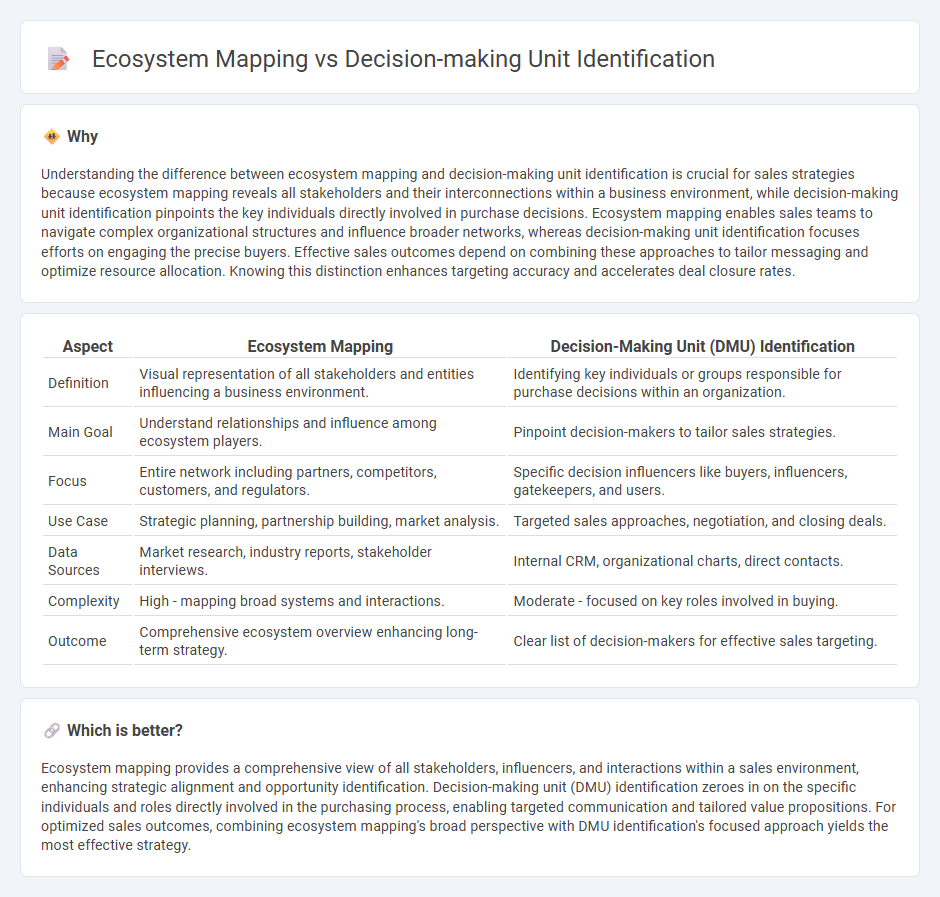
Ecosystem mapping in sales reveals the complex network of stakeholders and influences impacting a buyer's environment, enabling a comprehensive view of relationships and dynamics. Decision-making unit identification focuses on pinpointing the key individuals or groups with authority and influence over purchase decisions, ensuring targeted communication and resource allocation. Explore these strategies to enhance sales precision and effectiveness.
Why it is important
Understanding the difference between ecosystem mapping and decision-making unit identification is crucial for sales strategies because ecosystem mapping reveals all stakeholders and their interconnections within a business environment, while decision-making unit identification pinpoints the key individuals directly involved in purchase decisions. Ecosystem mapping enables sales teams to navigate complex organizational structures and influence broader networks, whereas decision-making unit identification focuses efforts on engaging the precise buyers. Effective sales outcomes depend on combining these approaches to tailor messaging and optimize resource allocation. Knowing this distinction enhances targeting accuracy and accelerates deal closure rates.
Comparison Table
| Aspect | Ecosystem Mapping | Decision-Making Unit (DMU) Identification |
|---|---|---|
| Definition | Visual representation of all stakeholders and entities influencing a business environment. | Identifying key individuals or groups responsible for purchase decisions within an organization. |
| Main Goal | Understand relationships and influence among ecosystem players. | Pinpoint decision-makers to tailor sales strategies. |
| Focus | Entire network including partners, competitors, customers, and regulators. | Specific decision influencers like buyers, influencers, gatekeepers, and users. |
| Use Case | Strategic planning, partnership building, market analysis. | Targeted sales approaches, negotiation, and closing deals. |
| Data Sources | Market research, industry reports, stakeholder interviews. | Internal CRM, organizational charts, direct contacts. |
| Complexity | High - mapping broad systems and interactions. | Moderate - focused on key roles involved in buying. |
| Outcome | Comprehensive ecosystem overview enhancing long-term strategy. | Clear list of decision-makers for effective sales targeting. |
Which is better?
Ecosystem mapping provides a comprehensive view of all stakeholders, influencers, and interactions within a sales environment, enhancing strategic alignment and opportunity identification. Decision-making unit (DMU) identification zeroes in on the specific individuals and roles directly involved in the purchasing process, enabling targeted communication and tailored value propositions. For optimized sales outcomes, combining ecosystem mapping's broad perspective with DMU identification's focused approach yields the most effective strategy.
Connection
Ecosystem mapping reveals the complex network of stakeholders and interactions within a market, enabling precise identification of decision-making units (DMUs) in a sales process. Understanding DMUs allows sales teams to target influencers, gatekeepers, and decision-makers effectively, optimizing resource allocation and communication strategies. Integrating ecosystem mapping with DMU identification enhances sales performance by aligning outreach with the roles and relationships that drive purchasing decisions.
Key Terms
**Decision-Making Unit Identification:**
Decision-making unit (DMU) identification involves pinpointing all individuals or groups responsible for making purchasing decisions within an organization, including influencers, gatekeepers, buyers, and users. This process helps tailor marketing strategies by understanding roles, authority levels, and the flow of information in the decision-making process. Explore further to learn how DMU identification drives targeted engagement and improves sales effectiveness.
Key Stakeholders
Decision-making unit identification centers on pinpointing individuals or groups with direct authority to make purchasing or strategic decisions within an organization. Ecosystem mapping extends beyond decision-makers to include influencers, users, and external partners shaping the broader environment and interactions. Explore how understanding both approaches enhances stakeholder engagement and optimizes business strategies.
Buying Center
Decision-making unit identification targets key individuals involved in the purchasing process, highlighting roles such as initiators, influencers, buyers, deciders, and gatekeepers within the Buying Center. Ecosystem mapping encompasses a broader view, capturing the network of internal and external stakeholders influencing or affected by the purchasing decision including suppliers, partners, and end-users. Explore how detailed insights into Buying Center dynamics enhance targeted marketing and sales strategies.
Source and External Links
Decision-Making Units (DMUs) - Poseidon - Identifies the collective stakeholders involved in purchasing decisions within organizations, including executives, managers, and end-users.
The Decision-Making Unit: The Who-is-Who of Your B2B Sales - Outlines key roles in a DMU, such as End Users, Champions, and Primary Economic Buyers, to understand the decision-making process in B2B sales.
Decision Making Unit (DMU): B2B & B2C Buying Center - Describes a DMU as a group influencing purchase decisions, often involving various stakeholders in B2B scenarios and less formal groups in B2C environments.
 dowidth.com
dowidth.com